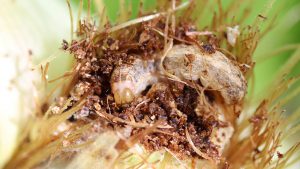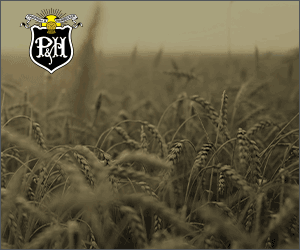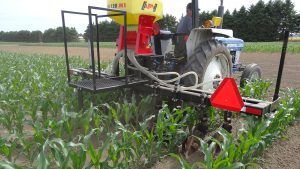Cropside: WBC thresholds/timing
AGRONOMIC INFORMATION FROM ONTARIO'S CROP SPECIALISTS

DELAYS IN PLANTING over the last few years have, in many regions, aligned the corn stages that the Western bean cutworm (WBC) moth prefers to lay her eggs on (pre-tassel to full tassel) and peak moth flight when moths are mating and laying eggs. Also, variable growth within each field has moths interested in remaining in that field instead of moving on to other later planted fields nearby. This is impacting both how and when we need to scout and also when to time the spray to be most effective.

WBC larvae only feed on tassel, silks, and kernels. There is no foliar feeding, so larvae are not killed if the insecticide is targeted on the leaves. Though larvae feed on tassels, it is only for a few days before they move down to feed on the silks and enter the ear. They cannot solely survive on tassel tissue and some may even head directly to the silks and ear, if it is already present. In other words, all larvae on any corn plant will need to make their way to the silks and ear to survive. Spraying in early tassel stages is not protecting the plant from the larvae that emerged after that spray.
WBC SCOUTING AND SPRAY TIMING FOR 2018:
- Determine when peak flight takes place in your region (Figure 1). Focus on the week prior to, during, and after peak flight. The exact dates may vary by a few days, depending on temperature and growing degree day accumulation.
- Target those fields in pre-tassel to full tassel stages during that three week period.
- Scout each of these fields every five days. Five day scouting intervals ensures that eggs haven’t been laid and hatched before your next visit.
- Accumulate the number of plants that have egg masses during each scouting trip.
- If five of the plants scouted over a two or three week period have had egg masses and/or small larvae on them, a spray is required.
- When threshold has been reached, hold off spraying until fresh silks are present on the plant.
- Target the ear zone when spraying. Ground application may be required to ensure good coverage on the silks and ear zone.
- A fungicide for ear mould protection can also be tankmixed at the same time to reduce the risk of ear moulds and mycotoxin development.
- Rotate your insecticide chemistries to reduce the risk of WBC developing resistance to widespread use of one chemical family.
Stay informed of in-season WBC activity by visiting Field Crop News, following @TraceyBaute on Twitter and #scout18. •











